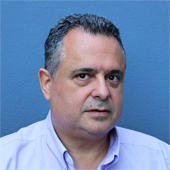David Robin of the Accelerator Technology and Applied Physics Division (ATAP) has been named project director of the Advanced Light Source Upgrade (ALS-U). He was chosen for this role by LBNL Director Michael Witherell in collaboration with ATAP Director Wim Leemans and ALS Director Roger Falcone. ALS-U recently received mission-need approval (known as Critical Decision Zero or “CD-0”) from the Department of Energy, giving the project its official start.
Fernando Sannibale, presently the principal investigator of the Advanced Photoinjector Experiment at LBNL, will take Robin’s place as leader of the ongoing ALS Accelerator Physics program in ATAP and will also serve as the ALS Division Deputy for Accelerator Operations and Development.
 Robin, a senior scientist in the ATAP Division and a Fellow of the American Physical Society, has been with LBNL since receiving his doctorate from the University of California, Los Angeles in 1991. After spending two years working on the design of the PEP-II B-Factory, he joined the ALS accelerator physics staff, leading the Accelerator Physics Group starting in 1999, then became ALS Deputy for Accelerator Operations and Development in 2005.
Robin, a senior scientist in the ATAP Division and a Fellow of the American Physical Society, has been with LBNL since receiving his doctorate from the University of California, Los Angeles in 1991. After spending two years working on the design of the PEP-II B-Factory, he joined the ALS accelerator physics staff, leading the Accelerator Physics Group starting in 1999, then became ALS Deputy for Accelerator Operations and Development in 2005.
During his tenure as group leader, Robin headed a number of highly successful ALS accelerator upgrades, including the superbend upgrade (completed in 2001) and the top-off upgrade (completed in 2009). He recently accepted the 2015 Secretary of Energy Achievement Award for the 2013 brightness upgrade of the ALS on behalf of the team led by his deputy, Christoph Steier.
“Dave has devoted much of his career to keeping the ALS at the forefront of light-source performance,” said Leemans. “Technologies, user demand, and opportunity are coming together to let us build the ultimate version of the ALS, and Dave and his team are in a great position to lead us there.”
ALS-U will enable the production of highly focused beams of soft x-ray light that are up to 1000 times brighter than that of the existing ALS by employing an improved electron storage ring. The new ring will use a dense array of powerful, compact magnets known as a multibend achromat lattice, which has been successfully demonstrated at the new MAX-IV facility in Sweden. In combination with other improvements to the accelerator complex, the new machine will produce highly coherent x-ray beams capable of probing matter with unprecedented detail.
“Now the real work begins,” added Robin, noting that CD-0 is just the start of the project, kicking off the conceptual design and project definition phase that must undergo rigorous reviews before achieving the next major DOE milestone, CD-1.
 To take Robin’s place as head of the ALS Accelerator Physics Program, Leemans and Falcone named Fernando Sannibale the ALS Division Deputy for Accelerator Operations and Development.
To take Robin’s place as head of the ALS Accelerator Physics Program, Leemans and Falcone named Fernando Sannibale the ALS Division Deputy for Accelerator Operations and Development.
Sannibale, a senior scientist in ATAP and a Fellow of the American Physical Society, has more than 25 years of experience in accelerator physics. His expertise includes storage rings for colliders and light sources, high-brightness electron sources, free-electron lasers (FELs), and accelerator instrumentation.
In addition to being a member of the ALS Accelerator Physics Program, for the last seven years Sannibale has been the principal investigator for APEX, the Advanced Photoinjector EXperiment. APEX is an injector test facility developed to test a novel concept called the “VHF-gun,” an electron source conceived at LBNL and optimized for operation in high-repetition-rate x-ray FELs. Based on the successful results at APEX, the VHF-gun has been selected as the electron source for the Linac Coherent Light Source-II, the high-repetition-rate FEL being built at SLAC National Accelerator Laboratory.
“David and Fernando are internationally admired accelerator physicists, they have made enormous contributions over many years at the ALS, and I am very pleased to see them engaged in these critical roles for our facility and our users,” said Falcone. “It’s a pleasure to work with them and the entire ALS accelerator physics team.”
“With the ALS-U CD-0 approval, the years to come will be an exciting but challenging period,” said Sannibale. “The needs of the operational ALS with its 2,500 users and the growing resource demand from the new ALS-U, must be carefully managed and coordinated by the two divisions’ leadership teams to ensure effective progress and success for both activities. I am looking forward to playing my part.”